On Dec. 6, 2018, Stampede Meat cut the ribbon on its new processing facility in Sunland Park, N.M., just across the state line from El Paso, Texas. The former Tyson Foods facility had sat idle for nearly four years but was the perfect fit for Stampede’s desire to expand beyond its Chicago-centric processing footprint, keeping its customers’ needs front-and-center. Andy Hanacek, editor-in-chief of The National Provisioner, visited the facility the day before the ribbon cutting for an exclusive behind-the-scenes tour, and also attended the ceremony. What follows is a portion of his one-on-one interview with president & CEO Brock Furlong, who walked Hanacek through the acquisition of the plant, how the renovation proceeded and what the new facility means for Stampede Meat’s future.
Hanacek: Let’s start with the general background of the acquisition of the Sunland Park facility. How long had this acquisition been in the works? What prompted Stampede to set its sights on expansion? How long did it take?
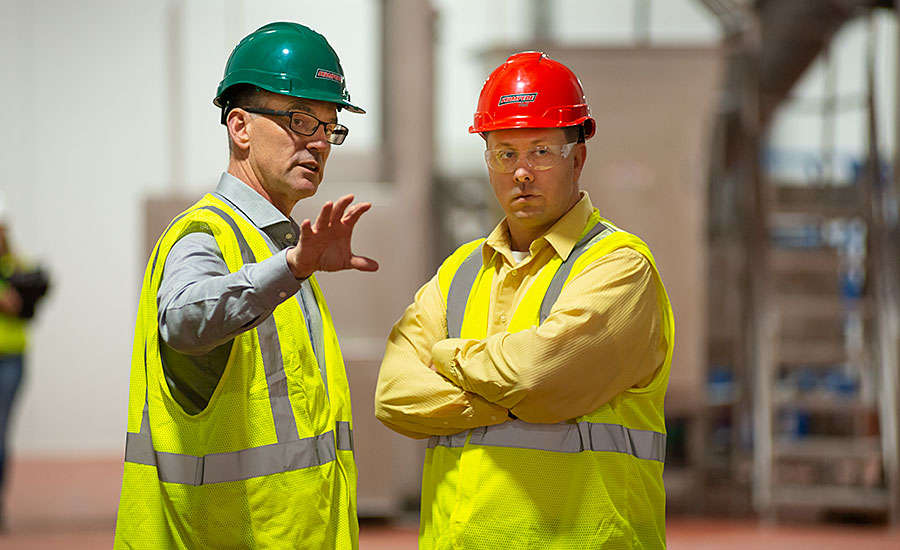
Brock Furlong, president & CEO of Stampede Meat, talks with Andy Hanacek, editor-in-chief of The National Provisioner, about the company’s plans for one of the large processing rooms on the raw side of the facility.
Furlong: We’d been in discussions with our customers for probably five or six years. Originally, the conversation started about having a national footprint to better support some of the larger customers we do business with, but that conversation evolved to include the need for new capabilities.
We initially thought acquisition was probably the better way to go, but we just couldn’t find the right fit. Culture is very important to us. The way that we approach our customers, the way that we do business with our customers, is critical to our success … Really being customer-centered, trying to execute their strategy and be nimble and flexible in that environment, isn’t the way many people in our space operate.
So, about three years ago, we decided that maybe the better route to go is either to build or buy something and renovate. We looked seriously at building in Chicago, [but our customers] wanted a broader geographic footprint for us, particularly toward the West Coast, because they felt that was an underserved region.
Hanacek: So, you were looking in several markets out in the Great Plains and toward the Rockies, focused predominantly on serving the western half of the U.S. better based on what your customers wanted most?
Furlong: Well, what started out as, “We need [Stampede Meat] to have a better geographic footprint for us to manage our national demand,” changed to, “Our needs are starting to morph and change. We’re going to do a lot more of our products cooked. We need you to expand both your cook capacity and capability in order to be able to deliver against our needs.”
Thankfully, we did not find a solution as quickly as originally hoped, because we would have sourced something very different than what we ended up getting in this facility.
We actually got down to a short list of four potential facilities a little over a year ago. We were heavily negotiating with each individual state at that stage, in terms of support packages, while working with our outside design engineering firm to determine facility fit. About six months ago, we started to feel like we belonged here in Sunland Park, N.M. We really did. We started to feel like this was the right fit for us. I guess the best way to say it was that it was welcoming. We felt the interviews that we were doing — not just at a city level and a state level, but even some of people that we were finding to support the due-diligence work — Sunland Park felt like Stampede. It felt like it would fit from a cultural standpoint.
The response time and the ability to craft something that worked for us was much quicker than we were able to get accomplished in other states, and because that’s how we deal with our customers, it felt real to us. We’re not here for the next year, or six months, or three months. We’re here for the next 30 years. With that timeframe in mind, fit was very critical to us and really drove the New Mexico site to the forefront.
Hanacek: The fit with the local government and the people was great, but what about the Sunland Park facility attracted you to it, just based on what you saw when you were doing your due-diligence? What made this facility stand out?
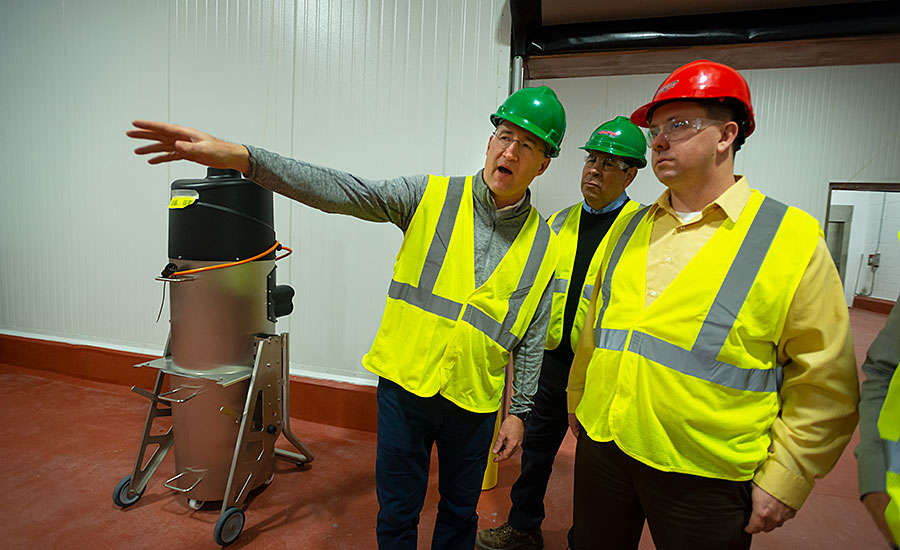
Jim Scott, COO, and Victor Granados, director of operations at Sunland Park, give Hanacek a visual explanation of how process flow will work in one of the facility’s raw processing rooms.
Furlong: First, before it closed in January 2015, it was [primarily] a foodservice facility, and [it was] a Tyson facility. So, No. 1, it was run properly, it was shut down properly. Those two things, very important. No. 2, it had the infrastructure, in terms of boilers, air, water, power, gas system and wastewater system to manage what we wanted to do. It takes out some of the unknowns if you know the facility was doing similar production to what you want it to do.
Second was its size. Our main facility in Bridgeview, Ill., is almost identical in size to this facility. It becomes very easy to parallel the two and complete a due-diligence assessment from basic flow to necessary power pack that supports a facility like this.
I would say that the third thing that was attractive was the labor pool. I don’t mean from an unemployment standpoint, it was more so the reputation of the facility. We went out to talk to customers that had been producing in this facility before, and they spoke volumes about the type of work ethic that they had seen when Tyson was running the facility. It had a very positive vibe in the customer community. That meant a lot to us, and we believed we would get the type of team members who would quickly adopt the five values we have as an organization. We felt quite confident our intimate approach to embracing our customers’ strategies would be embraced.
Lastly, I would say, it has winning conditions in and around Sunland Park, N.M., and nearby El Paso, Texas. When you’re running a facility like this, you need good third-party logistics support, and you need competitive freight rates. You need refrigerated and frozen food-grade trucking to be running in and around your facility. If you’re remote, it becomes very challenging to get trucking to come and pick up or drop off, not to mention expensive.
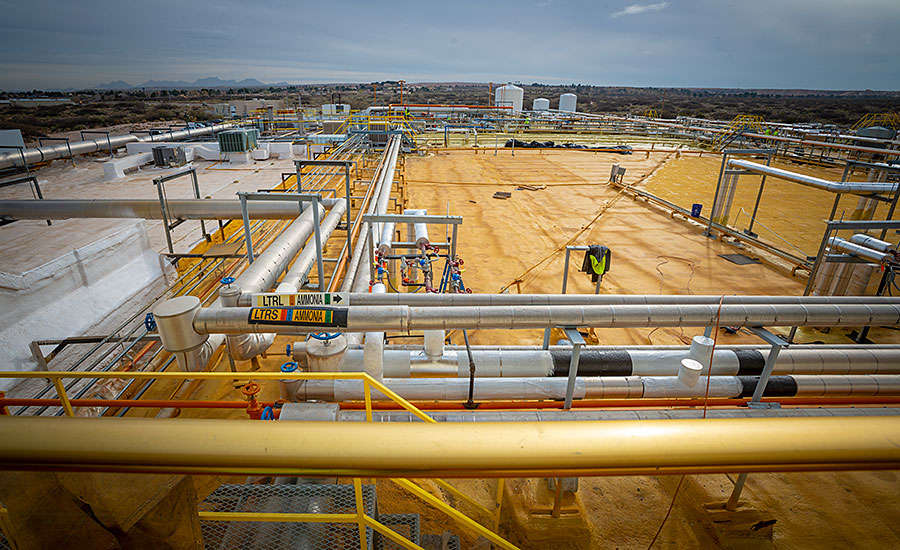
During The National Provisioner’s visit, crews were still applying foam insulation to the plant’s roof, which will eventually be covered with a bright white sealant to reflect the sun’s heat and help lower the cost of keeping the facility cooled, particularly during the hot summer months.
Hanacek: The ribbon cutting ceremony is tomorrow (Dec. 6), and the plant starts running on Monday (Dec. 10) — so obviously, you’ve hired employees and trained them already. How different has the transition been, given the distance between the other facilities you own and this one?
Furlong: We will have an executive team member here every week for the first year, because the most important thing for me is that the culture gets set right. It’s not about production. We’ll get the production right. We strongly believe we will secure new customer business. We will most definitely grow here. This facility’s got too many winning conditions not to. But what’s most important is that the way we approach our customers’ strategies and business is identical to the way we do it in all of our operations in Chicago, that it feels exactly the same when customers visit. That’s the priority that I’ve established for the team in Sunland Park, but also the leadership team in their interaction with this particular operation.
Hanacek: OK, with culture being so important, what have been some of the challenges and adjustments that you’ve had to face thus far in communicating and educating these new employees on the Stampede Meat culture?
Furlong: I would say that the most challenging thing that we’ve had to deal with is probably our value of “commit to teamwork” — in terms of really understanding what it means when you are a three-hour flight away. If we have a challenge to this value anywhere in our system today, we just get in the car and within 15 minutes we are there, we get the group together, we have a conversation, get it resolved, and then we are on to the next customer challenge or opportunity. That’s been a real learning curve for us as we move to start up our New Mexico operation.
We are definitely going to stretch the definition of a commitment to teamwork — really having the opportunity to understand it better over the next three to six months as we move into this facility. The necessity for communication, and clarity and frequency of that communication, is ramped up tremendously, in order to really live the value of committing to teamwork. The way that we’re starting to deal with that is by having open dialogue about what that’s going to look like, how that’s going to feel, and how we’re going to work through it in a positive manner now.
Hanacek: Let’s shift gears to the actual renovation of the Sunland Park facility once you got the keys. There are always challenges involved in any purchase and renovation; what were some of the hurdles Stampede Meat had to jump to get this facility designed and ready to run next week?
Furlong: I think we understood exactly what we were getting, for the most part as we did complete a pretty extensive due-diligence. But, yes, there were a couple of surprises. … Probably the biggest surprise was the floors. We thought we could scarify back to concrete and then put a new flooring treatment that we use in all plants in Chicago, but when we went through that process of grinding back, we realized that there were a lot of challenges in the floors that we hadn’t anticipated. … We ended up having to literally cut out the existing concrete and basically re-pour everything back so that we had the proper drain slope. As a side benefit, we were able to replace all of the drainage with stainless steel — which, while expensive, definitely fits with our commitment to food safety.
The other major finding we didn’t anticipate is that there wasn’t fire suppression throughout the facility. It was only in the dry storage areas of the facility. We never anticipated that because it was a cook facility and of course missed it during due diligence. That was, obviously, something that we weren’t willing to sacrifice, because it’s the safety of the employees at stake. We have fire suppression now throughout the facility.
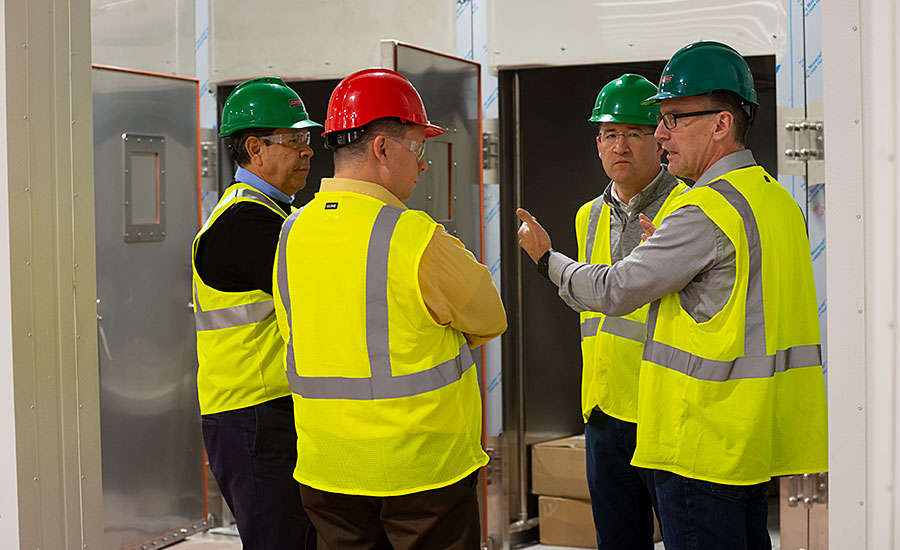
Hanacek discusses the different cooking equipment and capabilities that will be installed at the Sunland Park plant, with Granados (left to right), Scott and Furlong.
Hanacek: Agreed, the fire suppression installation was a necessity, but there wasn’t an interstitial space above the processing floors either, which was something Stampede wanted installed, correct?
Furlong: Right now, the weather outside is great because the lows are in the low 40s and the highs are in the 60s here, and you’d love to run a plant all year like that. But in the summer here, it’s going to be well into the 100s. We knew that, and so we wanted to put in an insulated interstitial roof throughout, because that drops your refrigeration cost. It’s less cubic space you have to refrigerate, but it also gives you that [insulating] gap.
The other thing that we did, though, was redo the roof, because it was your typical tar and rock. We’ve put about a four-and-a-half-inch layer of foam that acts as insulation and also protects against damage and leaks. Then on top of that, we put a sealant layer of white that reflects the sunlight. We are not going to get any of that summer heat into the concrete [roof] anymore. We’ve got a pure insulation layer there. Then inside the building, we’ve got the interstitial plant ceiling, so we’re not actually trying to cool right up to the concrete roof.
Finally, of course, we have all new refrigeration evaporators in the facility. The actual cost of running this plant is going to be substantially more efficient than what was here before.
Hanacek: On the tour, you mentioned new business and new opportunities that are completely different from your Chicagoland operations. So this facility will be doing some of its own, unique learning that has little to do with the Chicagoland operations?
Furlong: One of the things that I think is exciting about this facility is that we’re going to have some new capabilities. First, we’re going to have the ability to naturally smoke. We will also be able to execute products requiring post-cook lethality handling, so we can slice, dice, etc., post-cook, which is going to open up some new paths of business for us, but also represent some interesting learning. We don’t have that technology currently in our operations in Chicago, so as we learn that, we’re going to be able to transport that learning back into the mothership, if you will, learning both ways.
The open-air, natural smoke cooking is the “build it and they will come” part of the operation. We haven’t done that before. We’re putting in two six-truck ovens, so twelve trucks in total of natural smoke capability. We have had many customers ask us for these types of products, but we have never really been able to execute this ask for them until now.
We’re a capability-built organization. We have to be very careful though when we add equipment like this, so as to not contravene our strategy. Our strategy is to execute our customer’s strategy. In this case, we did know that there’s a dearth of capacity in natural smoke as it relates to ribs and brisket, and some other products. We are just now letting our customers know that we now have this capability and then we’re going to stand back and let them decide where it goes from here, as opposed to us presumptively pushing it. We always need to remember that our customers are in the driver’s seat and we are just a passenger in the car.
It’s very different from what we’ve done in the past, but we’re excited about it. We think the natural smoke is a really interesting way to go, for us — but more importantly, for our customers. We believe it will provide a compelling competitive platform for our customers to be able to menu products with a natural smoke call-out.
Hanacek: Because of the different capabilities expected here in Sunland Park, the process flow had to be different from your Bridgeview plant. Can you explain the primary points of emphasis the Stampede team had when designing the facility’s operations?
Furlong: First and foremost was our safety program. We designed with safety in mind. The quat crystal and the foamers at every entrance and egress to the facility, the flow from raw to cooked, the temperature controls, our layered interventions … everything that we did design-wise was to maximize the safety of what we do on behalf of our customers. We are managing billions of dollars of brand value every day on behalf of our customers, and we have to protect that brand value.
In Chicago, we have a separate cook facility and raw facility. This is a combined facility, about 65% cook and about 35% raw initially, which is a very different balance — a bit of a flip from Chicago. … There was a very detailed and deliberate thought process that went into how we were going to design our flow of people and process, with a very clear segregation between ready-to-eat and raw production processes. Now, we don’t have any post-cook lethality handling business that we’ll be doing in the facility on Day One, as our customers will drive our utilization of this new capability, but the design is already in place.
Last but definitely not least, we really wanted open spaces — really big rooms, large rooms, and you saw that in the tour. We wanted that space and visibility, even though we’re batch-oriented by definition, to ensure complete customer flexibility. This was a very chopped up plant when we saw it. Our goal was to take down as many walls as we could, and still get that consistent, food-safe flow and design. … Wherever the equipment is today, maybe with the exception of something like a spiral freezer, it can move tomorrow. That’s why the interstitial ceiling was so important to us. If we have to change the flow of the operation for a new type of customer business, we can do that. New drop downs, new air, new water, new power? Done. It may change again the next week, or the next month, but we’re OK with that because we’re operating to our customer’s strategy.
Hanacek: Monday is the first day of production, starting up your grind line. Beyond that initial milestone, what is the timeline for turning on the lines and then filling up production?
Furlong: Initially we are starting with our own retail products, so we move through the learning curve with our own products at risk, not our customers. … I’ve got this philosophy with the company: crawl, walk, run. If you’re crawling and you fall, you don’t really hurt yourself. If you’re walking and you fall, you don’t normally hurt yourself, but you’ve learned a lot from crawling, so the risk of falling is far less. By the time you’re running, though, you’ve got to be really confident. Here in Sunland Park, we are going to move through crawl-walk-run relatively quickly, probably over the next six to eight weeks.
We’ve had a tremendous amount of interest already in the facility and its capabilities, and we are moving through customer approvals more rapidly than even I expected. As we ramp up though, we will make sure that there’s constant communication around the logistics and the things that we’re doing for our customers. So that if they have an issue or a concern, it’s addressed right away, and they get a response immediately.
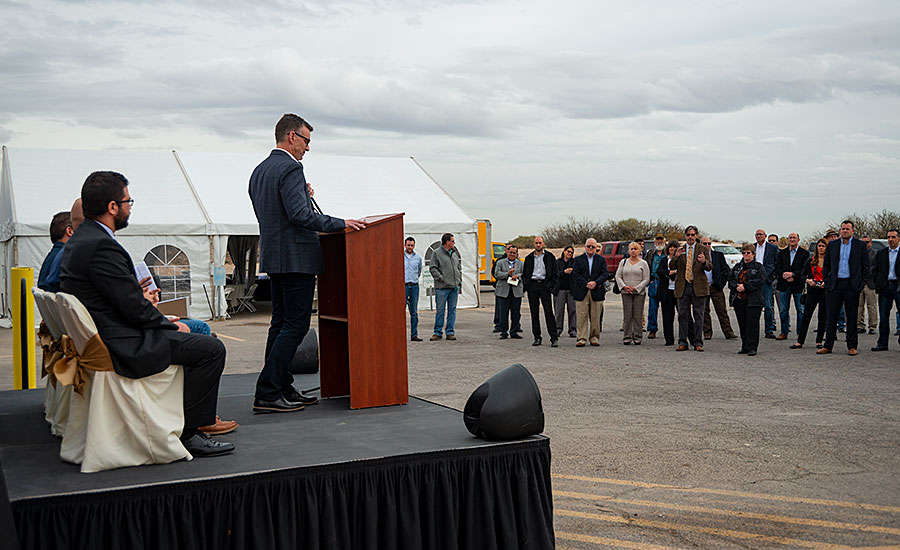
Furlong addresses the crowd during the ribbon-cutting ceremony at the Sunland Park facility Dec. 6, 2018.
Hanacek: We touched on the future of this facility a bit, and what this facility means for the future of Stampede Meat, but look into your imaginary crystal ball here for a minute and tell me what you see down the road for Stampede Meat in the coming years.
Furlong: Crystal balls are always unique to you, always pretty fuzzy and always wrong. With that caveat in mind, I can see a future in which we are going to be looking at expansion here or additional investment on behalf of Stampede either in the state of New Mexico, or elsewhere in the next two to three years. That is because I believe this facility will be full in the next three to four years. I hope that to be true for the region, because we’ve had such a positive outpouring for employment here — more than 3,000 applications already. I don’t think we’ll ever employ 3,000 people here, as the facility is simply not that big, but I think that in three to four years, we’ll be north of 1,000 people for sure, which I think is just a wonderful thing to do in a community like this.
For Stampede, it’s the most significant investment that we’ve made in our nearly 24 years in business. It’s the first time we’ve been outside of the Illinois market, so it’s scary but in a good way. The expression I use with the organization is, cautiously optimistic but persistently paranoid as we move to scale up our New Mexico investment. We’ve had very strong interest already, from both existing and new customers, in what this facility can mean to them in terms of their current supply chain strategies.
I wish that we had discovered this facility two or three years ago, but I believe things always happen for a reason. A bunch of disparate things had to align, but it’s all come together now. My belief is customers do business with people that they like and have confidence in. This was a well-liked facility with strong customer confidence in both the people and the asset. In the customer conversations that we’ve had, they really loved this facility. I genuinely believe that based on the significant renovation we have completed, there isn’t a customer that was in the facility before that’s not going to want to entertain executing their sourcing strategies in Sunland Park, N.M., again. NP
PHOTOS BY JOHN SHIPES, SHIPES STUDIO



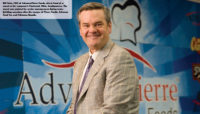
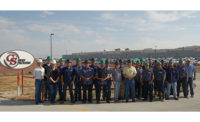
Report Abusive Comment